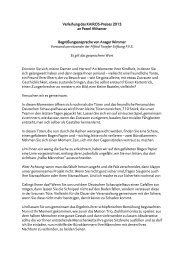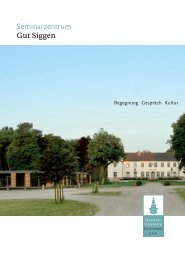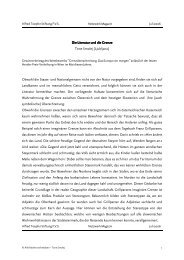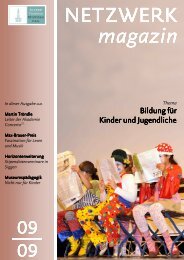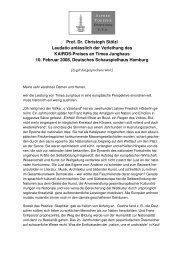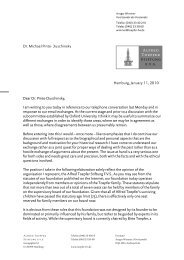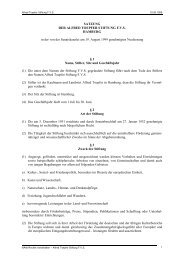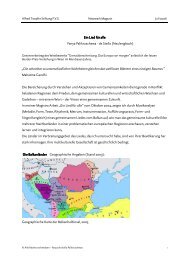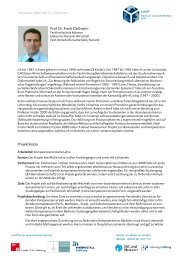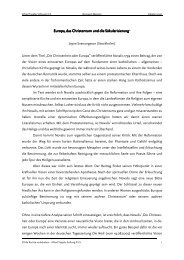Ansgar Wimmer - Alfred Toepfer Stiftung F.V.S.
Ansgar Wimmer - Alfred Toepfer Stiftung F.V.S.
Ansgar Wimmer - Alfred Toepfer Stiftung F.V.S.
You also want an ePaper? Increase the reach of your titles
YUMPU automatically turns print PDFs into web optimized ePapers that Google loves.
Awarding of the KAIROS Prize 2012<br />
to Katell Gélébart<br />
Deutsches Schauspielhaus Hamburg<br />
4 th of March 2012<br />
Welcome speech by <strong>Ansgar</strong> <strong>Wimmer</strong><br />
Chairman of the Executive Board of the <strong>Alfred</strong> <strong>Toepfer</strong> <strong>Stiftung</strong> F.V.S.<br />
Nobody, ladies and gentlemen, no artist or musician, was as resourceful at recycling<br />
existing material as that grandmaster of composers, Johann Sebastian Bach, whose<br />
chaconne from the Partita in D minor for solo violin we have just now heard<br />
interpreted by Jérome Benhaim, an emergent violinist from France, and seen<br />
interpreted by the National Youth Ballet in a choreography by Yohan Stegli. Many<br />
knowledgeable musicological treatises have been written about “musical parody”, its<br />
most prominent Bachian examples are included in The St Matthew Passion or The<br />
Mass in B minor.<br />
“Bach’s Green Composing: the Beauty of Recycling” was the title of a feature in The<br />
Boston Musical Intelligencer in December 2011. The article was about a performance<br />
of The Christmas Oratorio at Harvard University, another composition which makes<br />
use of musical parody. The chaconne was probably not composed using this<br />
approach. Nevertheless, we thought its underlying compositional idea — namely, the<br />
variations dancing over a constant bassline — as well as its impressive virtuosity and<br />
intensity an appropriate choice to celebrate with you today “the beauty of recycling”.
And thus I bid you welcome on behalf of the <strong>Alfred</strong> <strong>Toepfer</strong> <strong>Stiftung</strong> F.V.S. at the<br />
presentation of the KAIROS Prize 2012 to the French recycling-designer, Katell<br />
Gélébart.<br />
To encourage and to congratulate the prizewinner in front of a full house, that has<br />
already been our desire in the previous years. To be on the spot at the right time, that<br />
is the aim of the KAIROS Prize. To behold the variety with curiosity, to feel out the<br />
close and faraway places of culture, to face anew what has been taken for granted, to<br />
discover what is there, to marvel at the mundane as well as the outstanding in culture<br />
and to learn, to see anew, to explore anew, to be aware again. To be alert and curious.<br />
I thank all of you for being our guests today, ready to chance a new perspective on the<br />
familiar, and for being curious about Katell Gélébart and her work.<br />
And it is with this attention and curiosity, great respect and affection that I am proud<br />
to welcome you, dear Katell Gélébart to our ceremony today. We are honoured and<br />
touched to have you as our prizewinner this year.<br />
With you, I warmly welcome your partner, your friends, members of your family, your<br />
mother and her partner as well as your mentor, Ron Rote, who will introduce us to<br />
you and your work later.<br />
Même si vous êtes chez vous dans beaucoup de pays, vous considérant vous-même<br />
comme une nomade moderne, permettez-moi de saluer tout particulièrement la
eprésentante de votre pays d´origine, Madame la consule générale Sylvie Massière.<br />
C´est pour nous un vif plaisir de pouvoir honorer avec cette cérémonie une lauréate<br />
française, chose qui n´est pas arrivée depuis longtemps. Nous sommes<br />
reconnaissants aussi bien à notre merveilleux violoniste Jérome Benhaim qu´au<br />
chorégraphe Yohan Stegli de nous aider à fêter votre compatriote.<br />
[Even if you feel at home in many countries and describe yourself as a modern nomad,<br />
please allow me to welcome the representative of your native country, the consul<br />
general, Mme Sylvie Massiere. After such a long time, we are delighted to honour a<br />
French prizewinner again at this prize ceremony. We are grateful to Jérome Benhaim,<br />
our marvellous violinist, and choreographer Yohan Stegli for their help in celebrating<br />
their countrywoman.]<br />
At this point it is necessary to welcome a variety of people, who have come because<br />
of the prize, but especially out of curiosity about the prizewinner and her work:<br />
companions and observers of her work and our work, respectively, colleagues from<br />
other foundations, the academic world and Hamburg and European culture,<br />
representatives of the Hamburg Parliament as well as the senate, of the media and<br />
the church, the diplomatic and consular corps, and I am especially delighted to<br />
welcome Mme Gélébart’s fellow campaigners from Greenpeace. I am glad that the<br />
members of our Foundation’s committees, the chairman of our board, Prof. Jürgen<br />
Schlaeger, and, above all, the members of the committee of the KAIROS Prize, with<br />
chairman Prof. Christoph Stölzl leading the way, are all here to celebrate the<br />
prizewinner chosen by you.
I extend a sincere welcome to the members of the founder’s family, <strong>Alfred</strong> <strong>Toepfer</strong>’s<br />
sons and grandchildren, who are also in attendance today. This year, the Foundation<br />
had its 80th anniversary and we are glad that you keep following our work with<br />
interest, dedication and advice.<br />
Moreover, we are glad about the range of well-known and unknown people, whose<br />
participation today is equally important as well as an honour for us.<br />
Every year we try anew to tell you a story with this award presentation, to make you<br />
curious about encountering ever new, surprising, impressive and inspiring<br />
biographies. It is less — or rather not at all — the life’s work that this prize is intended<br />
to honour. Nor are we looking for a brilliant debut, in order to promote young artists.<br />
In addition, we venture through the whole spectrum inbetween active artistic work,<br />
scientific discussion, right up to organisational aspects of culture, opening up spaces,<br />
the organisation of cultural relations. And neither is the the prize committee limited<br />
to a canon in what it perceives as culture; it follows a curious, but down-to-earth<br />
cultural self-confidence. The Prize always circles around the theme of “Identity”,<br />
whether in historiographic, artistic-ethnic, literary, dancing or theatrical analysis — or<br />
as today in the examination of identity through design and fashion.<br />
Like every other aspect of our Foundation’s work, this event focusses on the person<br />
promoted by the prize. Those who still observe the <strong>Alfred</strong> <strong>Toepfer</strong> <strong>Stiftung</strong> F.V.S.<br />
from a distance and think it is merely an institution that glorifies its founder, or that it<br />
is caught up in its past mistakes, has learned nothing - or does not want to learn.
Foundations are not an end in itself, and we have many reasons in our own history to<br />
take heed of not turning into one. If that is so, however, we are especially under the<br />
obligation to encourage those people we honour as prizewinners, not merely<br />
selectively with the presentation of the prize, reasonable prize money or through<br />
smart communication, but rather in lending our support persistently and actively to<br />
our prizewinners.<br />
That is exactly what we have tried to do in the previous years, in the wake of past<br />
award presentations, whether through promoting readings by Andri Magnason,<br />
lectures by Timea Junghaus, performances by Sidi Larbi Cherkaoui or keeping<br />
contact to Shermin Langhoff. This year, we are especially happy that the Museum für<br />
Kunst und Gewerbe (Museum of Arts and Crafts) agreed to make it possible to<br />
present Katell Gélébart’s work in a prestigious location, in immediate connection to<br />
the presentation — and without insisting on the usually necessary ahead-of-schedule<br />
work or the required resources. Let me personally and specifically express my<br />
gratitude at this point, to Sabine Schulze, director of the MKG, as well as her team,<br />
including the curator, Angelika Riley, and the architect, Sven Hillebrandt. This is an<br />
impressive and exemplary instance of the willingness to cooperate within Hamburg’s<br />
cultural scene.<br />
The title of the exhibition is „Was da ist“ (What is there), and it will be open to the<br />
public following this event. And it is with this thought exactly — an invitation to risk a<br />
curious glance at what is there — that I would like to open this event. In the upcoming<br />
ninety minutes, we, my colleague, Uta Gielke, and me, the Foundation invites you to<br />
win back what is there for you anyway, what you take for granted. Not only in meeting
Katell Gélébart and encountering her unique creative drive, but also in that which is<br />
actually guaranteed and familiar to you. The partner by your side, your health, the<br />
liberty to sit here — bow to that which is taken for granted, to meet it anew, relieved of<br />
its triviality. Meet anew what is there, and create it!<br />
Once again, I am glad that you are here, let me welcome you again — and now I will<br />
clear the stage for Ron Rote, Katell Gélébart’s companion and mentor.
Speech at the Presentation entation of the Prize<br />
To encourage and to congratulate the prizewinner in front of a full house, that has<br />
already been our desire in the previous years and it is our desire today.<br />
The KAIROS Prize is about supporting biographies at the right moment. Biographies<br />
that are outstanding and encouraging, European biographies, considerate of<br />
understanding, courageous and creative biographies.<br />
After the German musicologist, Dr. Albrecht Dümling, in 2007; the Hungarian art<br />
historian and curator, Tímea Junghaus, in 2008; the Belgian-Moroccan<br />
choreographer, Sidi Larbi Cherkaoui, in 2009; the Icelandic man of letters, Andri<br />
Magnason, in 2010; and the decided theatre maker and mentor, Shermin Langhoff,<br />
last year; now Katell Gélébart, the eco-designer, is the sixth winner of the KAIROS<br />
Prize.<br />
If you like, you may see in this series a programme that does not simply celebrate<br />
lissomeness and evident glamour that has already been frequently acclaimed. To be<br />
at hand with modesty at the right moment, to celebrate the rough edges, to feel out<br />
the close and faraway places of culture, to name what has been kept secret and to<br />
keep quiet about the clamourous, to keep up the dialogue about the sublime and<br />
about what is special in European culture and also to learn to see anew, to listen<br />
anew, to perceive anew, to be curious.<br />
And at the same time refrain from making demands and to step back instead. On that<br />
note, I want to ask Katell Gélébart to join me here on stage, for the presentation of<br />
the prize and reading out of the document:<br />
Ladies and gentlemen, the winner of the KAIROS Prize 2012, Katell Gélébart!
Concluding words<br />
At the end of this event I have to say thanks, an obligation I once again meet wholeheartedly.<br />
I ask you to forgive me, despite the advanced hour, if the thanks are more<br />
extensive this year:<br />
Of course, I would like to thank our prizewinner once again — thank you Katell —, but<br />
also thank you to all those, who brought inspiration onto the stage<br />
• That is why I have to thank Ron Rote, for his amicable look on Katell Gélébart,<br />
and Christoph Stölzl, for his knowledgeable laudatory speech for a<br />
prizewinner who is close to us.<br />
• In connection with our thanks to Christoph Stölzl, I would like to thank all<br />
members of the committee: dear Nike Wagner, Armin Conrad, Rainer<br />
Schaper, Heike Catherina Mertens, and, this year particularly, Christine Eichel<br />
- to whom we owe the reference to Katell Gélebart.<br />
• I want to thank those who lent their artistic talents to this prize ceremony,<br />
specifically the National Youth Ballet and its choreographer and ballet master,<br />
Yohan Stegli, also an outstanding dancer in John Neumeier’s company, as well<br />
as Lukas Onken, the managing coordinator of the National Youth Ballet, who<br />
agreed spontaneously and was exceedlingly cooperative to assist us with this<br />
ceremony. I was very impressed, how everyone got involved in this task, and I<br />
may, incidentally, use this opportunity to promote the National Youth Ballet<br />
as a young ensemble.
• One probably can dance to silence as well, but the wonderful dancing prelude<br />
would not have been possible without the virtuoso, ambitious interpretation<br />
of the chaconne by Johann Sebastian Bach, performed by Jérome Benhaim, to<br />
whom I want to extend my thanks.<br />
• Peter Shub has to be thanked as a “very special guest of honor”. He is one of<br />
the internationally most successful clowns and pantomimes, and he has<br />
bestowed on us a humorous view on what is there in his brilliant contribution.<br />
• Furthermore, I would like to thank Anette Poppenhäger and this year also<br />
Roxanna Dürr as well as 3sat Kulturzeit for the production of this wonderful<br />
and concise film about our present prizewinner. The cooperation has been a<br />
stroke of luck for this prize.<br />
• Special thanks go out to the Deutsche Schauspielhaus: its director, Jack<br />
Kurfess, but above all his team, especially Nils Stahl, Annette Heilmann,<br />
Annette Endmann, Rebecca Dahnke, Sebastian Reuter, the sound technicians<br />
and the many “invisible” helpers.<br />
• Please allow me to thank an ever hidden, yet present artist connected to the<br />
presentation of this prize — he is sitting here somewhere, hidden away in a<br />
box: It is Neil Saad, a highly valued gold smith from Hamburg, who designed<br />
the hourglass we present with the prize, and who fashions it with steady hand,<br />
year after year.<br />
• Last but not least, I want to thank our Foundation’s team, in place of various<br />
special colleagues, Uta Gielke, who supervises the KAIROS Prize and this<br />
ceremony thoroughly and ably. Thank you very much!
Usually, in the previous years, I have thanked you at this point for coming and for<br />
your interest and invited you to a reception in the lobby of the Schauspielhaus. This<br />
year, I have the pleasure to issue two invitations to you:<br />
Thus, following the prize ceremony, we have the opportunity to stay for a moment in<br />
the lobby for a glass of champagne or juice, to get into conversation with each other<br />
and also to congratulate Mme Gélébart.<br />
As I mentioned at the beginning, it is a special gift that the Museum für Kunst und<br />
Gewerbe has agreed to display Katell Gélébart’s works in a very fine exhibition. For<br />
this, I would like, once more, to thank Professor Schulze and the entire team of the<br />
museum and invite you in their name to stroll over to the MKG for the opening of the<br />
exhibition in about an hour. There will be no speeches then, but ample opportunity<br />
to continue the conversations, to have a close look at the prizewinner’s works and<br />
also to rediscover the MKG as a whole. It is an exceedingly generous gesture by the<br />
museum that all of you can use the the admission ticket for this ceremony to have<br />
free admission to the exhibition in the Museum für Kunst und Gewerbe until 6 p.m.<br />
With a view to the economic situation of Hamburg’s museums, I would like to<br />
emphasize as well that a donation is welcome nonetheless. And, of course, you can<br />
visit the exhibition a second time with friends on some other day, as it is open until<br />
May 6, 2012.<br />
Finally — and then I will conclude this ceremony for good —, I want to mention two<br />
more things: You probably know the “making of” part of a movie, where bloopers are<br />
shown while the end credits are rolling, scenes which haven’t found their way into<br />
the movie proper. Today, I would like to reveal such a blooper concerning this<br />
ceremony, especially, because it was so delightfully absurd and that alone makes it
worthwhile to uncover it: Earlier in the film, you saw an old metal Venetian blind<br />
which Katell had found in India and sent to us for processing by German mail? And<br />
you have watched Mme Gélébart earlier fashioning a lampshade from such a<br />
Venetian blind. Well, that was not the same Venetian blind: the original blind from<br />
the Indian garbage is well protected, kept under wraps at the customs office here in<br />
Hamburg, because it was classified as art, although it hadn’t been finished yet, and<br />
customs disagreed about the customable value of this commodity. Since we were not<br />
prepared to pay many times over the original value of the blind for customs duty and<br />
handling fees, the blind remains there awaiting its collection. At least the customs<br />
office of Hamburg has gotten the message of this prize ceremony, about the value of<br />
what is there. Our warm greetings go to the customs office!<br />
And one last thing: Last Sunday I was at Kampnagel, here in Hamburg, where the<br />
Ensemble Resonanz, in association with the HipHop Academy Hamburg, presented<br />
“Sampled Identity”, a production well worth seeing. Courting originality as organiser<br />
of today’s ceremony, to be honest, I had a scare, when I noticed that part of this<br />
production included Franklyn Kakyire, a member of the HipHop Academy’s<br />
Ensemble, dancing enchantingly to Bach’s chaconne. However, since the theme of<br />
this prize and ceremony is the “Beauty of Recycling” and encountering the familiar,<br />
my colleague, Uta Gielke, and I have taken heart and brought together Jerome<br />
Benhaim and Franklin Kakyre to present to you, as a coda, an excerpt — not the<br />
complete chaconne - in a choreography by Denis “Kooné” Kuhnert.<br />
A big thank you to the dancer and violinist, to you for coming, for being our guests.<br />
And now, once again, from the Partita No. 2 in D minor for solo violin, the chaconne<br />
by Johann Sebastian Bach — “The beauty of recycling”.



